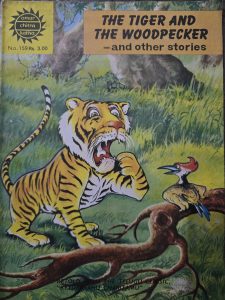
3998 - The Tiger and The Woodpecker
Author: Amar Chitra Katha
"The Tiger and the Woodpecker" is a classic Indian folktale that conveys a moral lesson about gratitude and friendship. Summary: The story is about a tiger who gets a bone stuck in his throat and is in great pain. A kind woodpecker offers to help by removing the bone. The woodpecker does this bravely, risking its own life by putting its beak inside the tiger's mouth. Once the woodpecker saves the tiger, it politely asks for a small reward or even a word of thanks. But the tiger arrogantly refuses, saying the woodpecker should be happy it wasn’t eaten. The ungrateful behavior of the tiger disappoints the woodpecker, highlighting how some individuals fail to appreciate help when they receive it. Moral of the Story: The tale teaches that kindness should be met with gratitude, and that selfishness and arrogance can destroy trust and goodwill. It's also a cautionary message about helping those who lack empathy or appreciation. Keywords: Folktale, Indian fable, Moral story, Animal characters, Gratitude, Friendship, Kindness and betrayal, Wisdom tale, Jataka tale (inspired by Buddhist lore), Talking animals, Tiger, Woodpecker, Selfishness, Courage, Compassion, Arrogance. Ideal For: Children’s Moral Education Teaches values like gratitude, kindness, selflessness, and respect. Helps children understand the consequences of ungrateful behavior. Classroom Use / School Curriculum Great for storytelling sessions, value education, or character-building activities. Can be used to spark discussion about ethics and personal responsibility. Visual Literacy & Reading Engagement The comic-book format is highly engaging for reluctant readers. Illustrations support visual learning, making the story easy to follow and memorable. Cultural Awareness Introduces readers to Indian folktales and moral traditions, possibly influenced by Jataka tales or Panchatantra themes. Good for multicultural or comparative literature units. Independent Reading Short, accessible language for beginner or intermediate readers. Family Story Time Makes for a meaningful read-aloud story with a discussion about morals at the end. Encourages intergenerational storytelling. Age: Ages 7 to 12 This range is ideal because: The language is simple and accessible. The moral is easy to understand and discuss. The comic-style illustrations engage young readers visually. For Younger Readers (Ages 5–6) Can be read aloud by parents or teachers with guided discussion. Useful for introducing values like kindness and gratitude. For Older Readers (Ages 11–12+) Can be used for moral reasoning, debates, or literature comparison (e.g., with Jataka or Aesop’s fables). Theme: Gratitude and Ingratitude The story emphasizes the importance of being thankful when someone helps you, and it warns against selfishness and arrogance. Other Supporting Themes: Kindness and Compassion The woodpecker helps the tiger selflessly, showing how helping others is noble—even when it's risky. Trust and Betrayal The woodpecker trusts the tiger, but the tiger breaks that trust by being ungrateful, showing that good deeds aren’t always rewarded. Wisdom vs. Foolishness The story also touches on using discretion when choosing whom to help, suggesting that wisdom should guide kindness. Moral Consequences The story has a clear message that actions—especially selfish or ungrateful ones—have consequences, socially or spiritually. Tone: 1. Didactic (instructional) The story is told with the intent to teach a moral lesson—that gratitude is essential and arrogance is wrong. 2. Cautionary There's a subtle warning in the tone: Don’t be naive in helping the ungrateful, and don’t misuse the help of others. 3. Gentle and Narrative Despite its serious moral, the tone remains calm, story-like, and accessible for children. It doesn’t preach harshly—it unfolds naturally through the characters’ actions. 4. Engaging and Visual Being a comic book, it uses lively dialogues and expressive illustrations that give the tone an engaging, storytelling feel—perfect for young readers. Book Type: Book Type: Comic Book / Graphic Novel Uses illustrated panels, speech bubbles, and narrative captions. Part of the Amar Chitra Katha comic series. Children’s Literature Written specifically for young readers, generally ages 7–12. Folktale / Fable Adaptation Retells a traditional Indian moral story, possibly influenced by Jataka or Panchatantra tales. Moral Story / Didactic Fiction Designed to teach a life lesson, especially about values like gratitude and kindness. Cultural / Mythological Retelling Reflects Indian storytelling traditions, making it suitable for cultural education. Length: Approximately 32 pages long.
